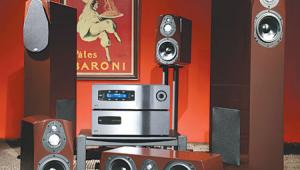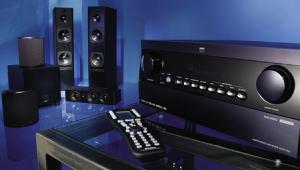Vienna Acoustics Beethoven Baby Grand Speaker System, REL R-305 Subwoofer, and Optoma HD72 DLP Projector
Say your Great-Aunt Edna died and left you $10,000 or so in her will with the stipulation that you had to spend it on a home theater system (that's why she always was your favorite great-aunt). You and I could while away the better part of an evening arguing the particulars of what gear to buy—and especially how the money should be divided between the audio and video parts of the system.

Like a lot of people, you might (sadly) lean toward pairing the largest, most expensive plasma TV with the cheapest, most basic home-theater-in-a-box. In a more reasonable approach, you might split the system budget down the middle with half on the video and half on the audio. For audio-oriented guys like me, though, even that seemingly sensible route is painful to contemplate. (Hey, we all have our biases.)
Although I don't claim to be able to communicate with the dearly departed, I think Great-Aunty Edna had in mind something eerily similar to the Spotlight System for this month. It has a full-bore audio system built around Vienna Acoustics speakers, an REL Sub-Bass System, and a Primare processor/Say your Great-Aunt Edna died and left you $10,000 or so in her will with the stipulation that you had to spend it on a home theater system (that's why she always was your favorite great-aunt). You and I could while away the better part of an evening arguing the particulars of what gear to buy—and especially how the money should be divided between the audio and video parts of the system.
Like a lot of people, you might (sadly) lean toward pairing the largest, most expensive plasma TV with the cheapest, most basic home-theater-in-a-box. In a more reasonable approach, you might split the system budget down the middle with half on the video and half on the audio. For audio-oriented guys like me, though, even that seemingly sensible route is painful to contemplate. (Hey, we all have our biases.)
Although I don't claim to be able to communicate with the dearly departed, I think Great-Aunty Edna had in mind something eerily similar to the Spotlight System for this month. It has a full-bore audio system built around Vienna Acoustics speakers, an REL Sub-Bass System, and a Primare processor/integrated amp. The lean, mean video package includes an Optoma DLP front projector and a Primare DVD player.
I reviewed the Primare gear as part of the Spotlight System in our October 2005 issue, so I'm not going to dwell on it in depth, other than a brief recap. Primare's SPA21 is a five-channel (100 watts each) integrated amp with a seriously sweet-sounding onboard processor. Its strong points are extremely musical and exquisitely detailed sound processing, loads of standard inputs, and exceptional ease of use. Its weak points are a minimal remote control and limited HD switching (two component inputs only—no HDMI or DVI). Primare's DVD26 is a top-notch progressive-scan DVD player that, alas, isn't compatible with DVD-Audio or SACD. These two pieces of Danish gear make a high-end electronics combo that's long on performance but short on glitz.

Requiem
Several years ago, I had the chance to live with a set of Vienna Acoustics speakers and fell in love with their open, airy character, as well as their gorgeous aesthetics. Vienna Acoustics has the habit of naming their speakers after famous Austrian and German composers. It sounds a little presumptuous, I know. But the company is actually located in Vienna—imagine that—and is steeped in the city's musical sensibilities. (Just be glad they didn't decide to name the speakers after varieties of sausage.)
Vienna Acoustics has since reworked the models I was familiar with—"outstanding" wasn't good enough praise, I guess. To both acknowledge their heritage and yet distinguish the new versions, the company has attached the "Grand" surname to the composers' names. For this month's system, Sumiko, the North American importer for Vienna Acoustics, sent me a pair of Beethoven Baby Grands, a Maestro Grand center-channel speaker, and a pair of Bach Grands for the surround channels. (So "Maestro" wasn't a specific composer. Get over it.) it.) Sumiko also sent a new REL R-305 Sub-Bass System.
The first thing I noticed about the new speakers was that Vienna Acoustics has upped the ante on the fit and finish. These speakers are even more refined, with an heirloom-furniture look and feel. Unless you have a wood-related phobia, you'll be hard pressed not to find their subtle yet obvious beauty irresistible. Tall and slender, the front and surround speakers create the optical illusion of appearing smaller than they really are. The narrow front baffles, with their curved edges, have the added sonic benefit of minimizing early reflections and diffraction effects—perhaps that's part of why they sound so open and natural.
The sophisticated design of the speakers' thin, sturdy grilles has both auditory and visual benefits, too. The aluminum grille frame contains a V-shaped phase diffuser down the center that helps control dispersion. Vienna Acoustics says, as a result of the unique design, you can leave the grilles on for everything but the most critical listening by the most finicky listeners. The V-shaped diffuser creates a groove, visible on the front of the grille, that adds an additional elegant visual touch.
One of Vienna Acoustics' strengths is designing drivers. Their proprietary midbass and bass drivers have cone materials that share similar sandwich-style designs in which a softer polymer is sandwiched between layers of harder polymers (configurations referred to as XPP and X3P). The process creates an especially stiff cone that's self-damped and resists breakup. The Beethoven Baby Grand and the Maestro Grand include bass drivers with additional spider-web-like ribbing that's claimed to provide extra rigidity. For tweeters, Vienna Acoustics uses hand-coated silk domes specifically tailored for each model.
All three models are ported designs. The three-way Beethoven Baby Grand is actually a hybrid; only the ultralow-frequency driver is mounted in a ported chamber. But the port design in the Bach Grand is even more interesting. Not only is the smaller of the two floorstanding speakers ported in the front and the back—a design Vienna Acoustics claims stabilizes the cone's movement at the frequency where the driver and porting interact—but the tweeter is mounted on a wedge assembly located directly over the front port. As with past Vienna Acoustics models, rake—the tilt of the speaker—is very important. It takes a little extra effort to get the angle just right, but it's worth it for the additional transparency and focus you'll hear.
 Focus is the number-one characteristic you'll discover when you listen to the system. The tweeters exhibit exceptional resolution and can produce frequencies lower than what you'd find with a more typical tweeter. This lets it blend better with the midbass driver for a smoother overall tonal balance. This is especially evident with a high-resolution recording such as you'll find on Bucky Pizzarelli's Swing Live multichannel SACD (Chesky). The openness and transparency in the upper frequency range allowed the smallest details of room ambiance and the subtlest audience noises present in this live recording to come through clearly, locked into a three-dimensional space. Larry Chernicoff's "created" spatial envelope on his October multichannel SACD showed off the ability of the Bach Grands to blend with the Beethoven Baby Grands and the Maestro Grand to create a swirl of sound around the listener. Those Beethoven Baby Grands, by the way, are capable of extreme delicacy, as with McCoy Tyner's "Miss Bea" from the New York Reunion SACD (Chesky).
Focus is the number-one characteristic you'll discover when you listen to the system. The tweeters exhibit exceptional resolution and can produce frequencies lower than what you'd find with a more typical tweeter. This lets it blend better with the midbass driver for a smoother overall tonal balance. This is especially evident with a high-resolution recording such as you'll find on Bucky Pizzarelli's Swing Live multichannel SACD (Chesky). The openness and transparency in the upper frequency range allowed the smallest details of room ambiance and the subtlest audience noises present in this live recording to come through clearly, locked into a three-dimensional space. Larry Chernicoff's "created" spatial envelope on his October multichannel SACD showed off the ability of the Bach Grands to blend with the Beethoven Baby Grands and the Maestro Grand to create a swirl of sound around the listener. Those Beethoven Baby Grands, by the way, are capable of extreme delicacy, as with McCoy Tyner's "Miss Bea" from the New York Reunion SACD (Chesky).
Six Feet Under
The Vienna Acoustics floorstanding speakers are quite good at creating bass on their own. Depending on your musical sensibilities, you could easily get by without a subwoofer. But, for movies, really, who can live without one?
REL's new R-305 definitely isn't one of those "more boom for your room" subwoofers. This British company makes Sub-Bass Systems—a type of speaker engineered to provide a foundation of bass for your main speakers to build upon. As such, the R-305 creates a perfect substructure for the Vienna Acoustics system that extends already-good bass down to "Damn, I didn't know that was in the recording" performance. A good example is in Sara K.'s acoustic rendition of "Brick House" (Hobo, Chesky), during which the R-305 brought out the barest dynamics of her foot tapping out the beat during the otherwise quiet moments of the song.
Visually, the R-305 is a stunner. It's a black box, yes, but with a hand-rubbed piano-black lacquer finish (with no less than eight layers), an offset grille, and machined lines on the lacquered surface. Mounted underneath the cabinet behind a frosted-glass security panel is the sub's control box, which you can locate remotely if desired. As with all REL Sub-Bass Systems, you can adjust the high- and low-level inputs independently and operate them simultaneously.
I'm not sure what I expected to hear with Telarc's Tchaikovsky 1812 Overture multichannel SACD, but what I got were some of the tightest, most controlled cannon shots I've ever heard from a system. It wasn't one of those "Ooh, that was cool" moments. Instead, it caused a jaw-dropping reaction, due to the overwhelmingly realistic reproduction—from the opening, high-frequency attack of the cannon shot, to the throaty follow-through. It was a tour de force of system blending and integration. I can say the same for the system's performance with Master and Commander's early sneak attack scene, as well as the Shinto-bean-flinging, circle-of-drums scene in House of Flying Daggers. I could pick out every piece of shrapnel and every flying bean, even as the room was being flooded with low frequencies.
Mine Eyes Have Seen the Glory
Now that we've blown the bulk of your inheritance on audio gear, we have to scramble to find a cheap TV, right? Fortunately, video-display manufacturers are currently relentless in their pursuit of market share, with each one working toward better performance at lower prices. One of the more aggressive companies is Optoma, and their new HD72 DLP front projector is a force to be reckoned with at its $1,999 price.

The HD72 uses a single 0.65-inch DarkChip2 DLP chip and a seven-segment color wheel. The chip has a 1,280-by-768 native resolution. The projector also uses TI's BrilliantColor technology. More importantly, I found it to have remarkably bright, vivid colors with an exceptionally sharp picture that was much more than I expected with such a relatively inexpensive projector. Fan noise was about average, but, when the HD72's Image AI circuit is engaged, the fan speeds up or slows down, depending on how bright the bulb is at that moment. If you're sitting close to the projector, this can become a little distracting. The HD72 isn't quite as flexible in terms of room-placement options as some projectors, but, in my room, the physics worked perfectly with an 80-inch Stewart screen. High-definition sources looked beautiful, and I was also pleasantly surprised to see how good plain old NTSC looked. Overall, I was quite smitten by this little powerhouse of a projector.
If you're an image-quality fanatic, you can certainly find better projectors—although it's highly doubtful you will for $1,999. You'll have to spend more on a projector—skimming off the audio budget—and then we'll go back to that evening-long discussion we started with.
When There's a Will. . .
Thanks in large part to the spectacular affordability of the Optoma HD72, you can put together a system with a great picture and still focus on phenomenal audio performance. I have to say that this setup is about as perfect as an audio-oriented guy can get. You might even say that it's truly a system to die for. Thanks, Edna.
(By the way, to put your mind at rest, no actual Great-Aunt Ednas were harmed during the writing of this review.)
- Log in or register to post comments






















































